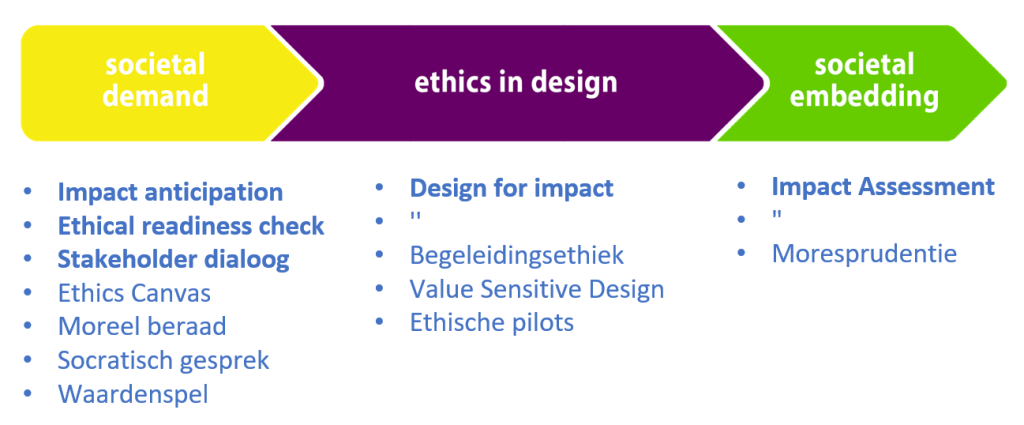In the Saxion lectorate Ethics & Technology, we work on tools, both for Responsible Research and Innovation and for education and professionalisation in the field of ethics and technology. To this end, we use, among others, the Product Impact Tool (Dorrestijn 2020; Dorrestijn & Eggink 2014). We are developing new tools, such as a Ethical Readiness Check. We explore and apply other tools, developed elsewhere, for example CTA-Toolbox (by Schulze-Greiving and Konrad). With an integral series of tools, we make Responsible Research and Innovation practical. We call this approach an Ethical parallel track for innovations.
We consider that ethics should be an integral part throughout the innovation process. This may not always be fully realisable, as the expertise, attention, time, work force are not always available. To still get as far as possible with the integration of ethics, we aim to make available a series of tools for interventions that can be carried out in the different phases of an innovation process.

If we consider technical development as a process, with a number of steps, the blue in the diagramm, then the cloured line beneeth represents the ethical parallel track. It has three broad stages. The ethical process runs all along the process of technical developent. We let it begin earlier and have it run beyond the technical process. While a design process starts with a problem statement, the ethical process should take a step back from there, and broaden the problem statement tot an exploration of societal demand and public values. On the other end, when a product becomes introduced in society, this means the completion of technical development, but for ethics it means an important stage of societal embedding where actual effects become revealed.
The ethical parallel trajectory approach strives where possible for ethical adjustments to innovations. Even if design improvement in the short term cannot be guaranteed, the approach can guarantee room for ethical reflection about the innovations and ethical professionalisation in the organisation with with effects in the longer term.

The Ethical Parallel Programme is open and scalable. Tools we develop, such as Ethical Readiness Check and Product Impact Tool can be deployed as needed. Existing tools, developed elsewhere, can also be applied. Think of Moral Deliberation, Socratic Conversation, Value Sensitive Design, Guidance Ethics.
The Ethical Readiness Check is ideally suited as the start of an ethical parallel track, and to monitor progress of “ethical readiness”.
The Product Impact Tool can be used at different stages, for:
- anticipating impact,
- designing impact and
- evaluating impact.
We are developping methods for Ethical Stakeholder Dialogue, including role playing games.
References
Casus: Ethisch Paralleltract Qoronano – brochure (in Dutch)
S. Dorrestijn & W. Eggink (2014), Product Impact Tool Workshop: Mastering Affect and Effect in Human-Product Relations. In: Salamanca, J., Desmet, P., Burbano, A., Ludden, G., Maya, J. (Eds.). Proceedings of the Colors of Care: The 9th International Conference on Design & Emotion. Bogotá, October 6-10, 2014 (pp. 467-469). Bogotá: Ediciones Uniandes. download
S. Dorrestijn (2020), A Tool for the Impact and Ethics of Technology: The Case of Interactive Screens in Public Spaces. In Heather Wiltse (Ed.), Relating to Things: Design, Technology and the Artificial (151-172). London & New York: Bloomsbury. download draft · publisher website